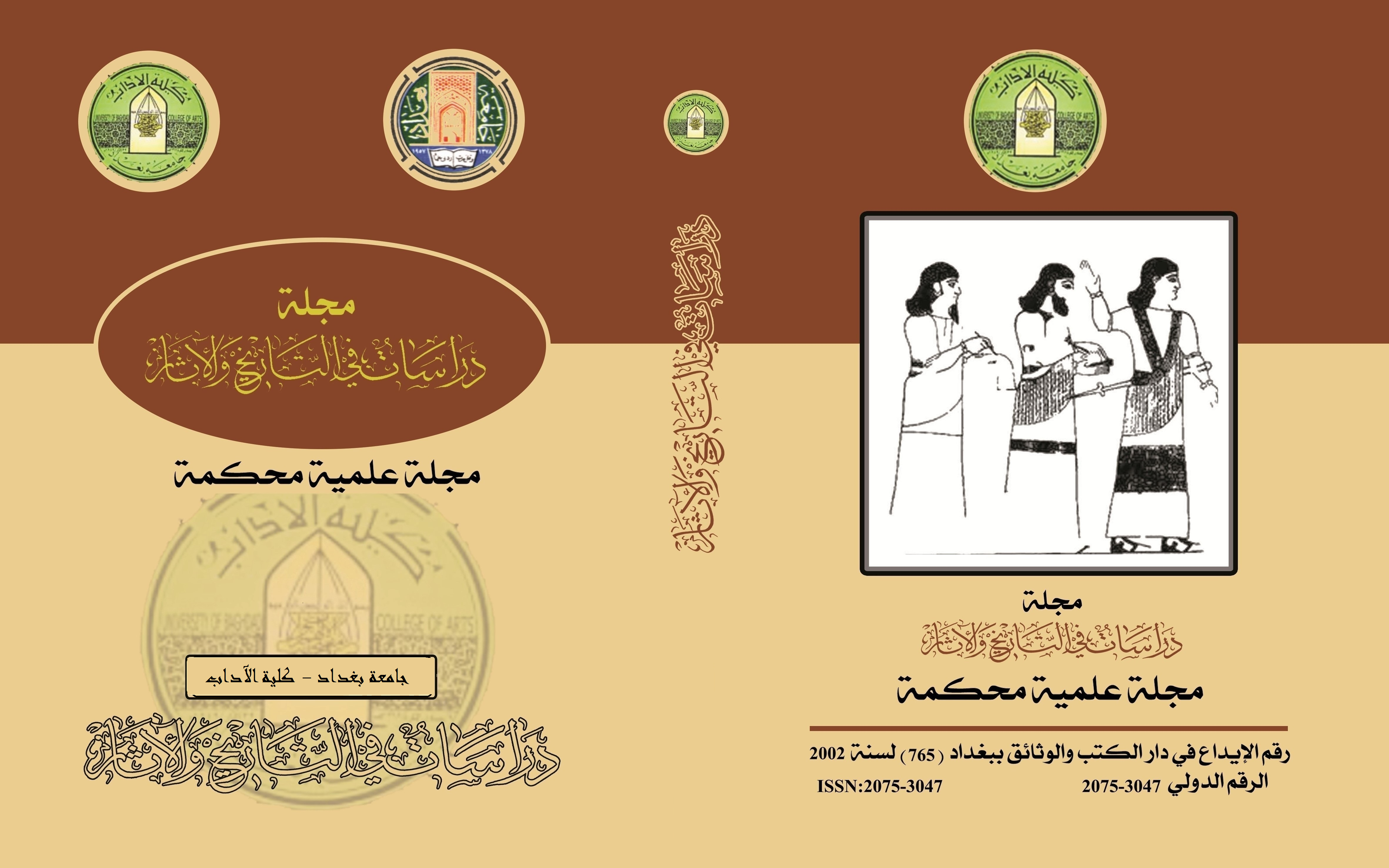روما والسابنيين بين الواقع والاسطورة دراسة تاريخية
الكلمات المفتاحية:
روما، سابنيين، اسطورةالملخص
روما والسابنيين بين الواقع والاسطورة ومن خلاله استطعنا البحث عن اهمية تلك القبائل المعروفة بالسابنيين ومن المعلوم ان السابنيين كان لهم تاريخ حافل بالمنجزات ابتداءً من سيطرته على أهم اتحاد الا وهي الاتحاد السباعي وتوسعهم على الأقاليم المجاورة فضلاً عن التركيبة الجغرافية واثرها في تلك القبائل.
ومن الملاحظ عليه ان تلك القبائل كانت بين السلم تارة، والحرب تارة مع روما وارتبطت معها بتاريخ حقيقي مغلف بالأسطورة، ولربما ان الاساطير كان لها شأن كبير في تأسيس روما، ولعبت اسطورة السبانيين مع الرومان دوراً كبيراً في تشكيل الوعي وتكوين شخصية الافراد والجماعات، وهي تعد القالب الذي تصهر فيه افكار ومعتقدات الشعوب وتصبح فيما بعد موروثهم الحضاري والثقافي وعلى اثر تلك الاسطورة التي تشير الى الحروب السابينية – الرومانية فقد تم تنصيب الملوك الذين أثبتوا اهمية العنصر السابيني في تاريخ الرومان، وعلى هذا الأساس تم تقسيم بحثنا هذا الى ثلاثة محاور يتضمن الأول اصل القبائل السابينية، والتي من خلاله تم التعرف على الموقع الجغرافي، ومناطق النزوح لتلك القبائل اما المحور الثاني فيشمل الحرب بين روما والسابنيين ويوضح هذا المبحث دور الاسطورة للشخصيات، وهل هي فعلاً شخصيات حقيقية ام مجرد اسطورة ارادوا من خلالها تمجيد شعب كامل ويشمل المحور الثالث الملوك السابنيين واهم منجزاتهم.
واما اهم المصادر التي تم الاعتماد عليها في هذا البحث الموسوم هو كتاب تاريخ وحضارة الرومان للمؤلف السيد احمد الناصري وكتاب سامي سعيد الأحمد تاريخ الرومان وكتاب ابراهيم السعدني حضارة الرومان. وكتاب لمؤلفه ش.جـ. س طومسون، السحر طقوسه واسراره، كذلك كتاب الفكر العسكري لمؤلفه رجب سلامة عمران.
وفي الختام ندعو الباري عز وجل ان نكون قد وفقنا في الالمام في تاريخ هذه القبائل في هذا البحث.
المراجع
اولا: المصادر العربية
- ابراهيم نصحي، تاريخ الرومان منذ أقدم العصور حتى عام 133 ق.م، د.ك، 1978م) ج2.
- اندريه ايمار، وجانين ابويه، تاريخ حضارات العالم، روما وامبراطوريتها (بيروت، دار عوينات، 1986).
- سامي سعيد الاحمد، تاريخ الرومان، (بغداد، جامعة بغداد، د.ت).
- دياكوف س.كوفاليف، الحضارات القديمة، ترجمة: نسيم واكيمم اليازجي، (دمشق، دار علاء الدين، د.ت).
- رجب سلامة عمران، الفكر العسكري الروماني بين الدفاع والهجوم والتوسع والاستعمار، (القاهرة، مكتبة الثقافة، 2010).
- سيد احمد علي الناصري، تاريخ وحضارة الرومان، (الفيوم، المركز العربي للطباعة، 1982).
- ش.ج.س طومسون، السحر وطقوسه واسراره، تعريب: سمير شيفاني (بيروت، المكتبة الثقافية،د.ت).
- شار سبنيوس، تاريخ حضارات العالم، ترجمة: محمد كرد علي، (الجيزة، الدار العالمية، 2012).
- طلال حرب، معجم اعلام الاساطير والخرافات في المعتقدات الدينية (بيروت، دار الكتب العالمية، د.ت).
- علي عكاشة وشحاذه الناطور وجميل بيضون، اليونان والرومان، (الاردن، دار الامل).
- فاروق خورشيد، الاسطورة عند العرب، (القاهرة، المكتبة الثقافية الدينية، 204).
- محمد محفل، دراسات في تاريخ الرومان، (جامعة دمشق، د.ت).
- محمود ابراهيم السعدني، حضارة الرومان منذ نشأتها وحتى نهاية القرن الاول الميلادي، (القاهرة، عين للدراسات والبحوث، 1998).
- ابن منظور، لسان العرب، مج4، (بيروت، دار صادر، 1990).
- نجيب ابراهيم طراد، تاريخ الرومانيين، (بيروت، المطبعة اللبنانية، 1886).
- هشام الصفدي، تاريخ الرومان، (لبنان، دار الفكر، 1967).
- هيثم هلال، اساطير العالم، ط1، (بيروت، دار المعرفة، 2017).
ثانيا: المصادر الأجنبية:
- Brian Haring, Agustine and Roman virtu, New York, 2008..
- Jolius C. H, and Cnnop T.A, History of Rome, printed byy Jamoskay, Jun and Broth 122, Chestunt street, vo.1.
- Ogilive, R.M, Ealry Rom and the Etruscan sussev, 1976.
- Poul Ropert, lepetit Robert, Avenue, pormentier paris 1986.
- Thorsten Fogen, Teats and Grgingin Greace – Roman world, Waltorde Grater Berlin, New York, 2009.
- Wald, The neam oof the Vestal or when A vestal is named, simitted, on 22 Jun, 2018.
ثالثا: الرسائل والأطاريح
- زينب سلمان سبع، الامبراطور نيرون سيرته ومنجزاته، رسالة ماجستير غير منشورة، جامعة بغداد، كلية الاداب، 2017.
- ريم صالح عبدالزهرة,الامبراطور اكتافيوس اغسطس سيرته ومنجزاته,رساله ماجستير غير منشورة جامعة بغدا-كلية الاداب 2016.
شكل رقم (1)
صورة رقم (2)
التنزيلات
منشور
إصدار
القسم
الرخصة

هذا العمل مرخص بموجب Creative Commons Attribution 4.0 International License.
:حقوق الطبع والنشر والترخيص
بالنسبة لجميع البحوث المنشورة في مجلة دراسات في التاريخ والآثار، يحتفظ الباحثون بحقوق النشر. يتم ترخيص البحوث بموجب ترخيص Creative Commons CC BY 4.0 المفتوح ، مما يعني أنه يجوز لأي شخص تنزيل البحث وقراءته مجانًا. بالإضافة إلى ذلك ، يجوز إعادة استخدام البحث واقتباسه شريطة أن يتم الاستشهاد المصدر المنشور الأصلي. تتيح هذه الشروط الاستخدام الأقصى لعمل الباحث وعرضه.
:إعادة إنتاج البحوث المنشورة من الناشرين الآخرين
من الضروري للغاية أن يحصل الباحثون على إذن لإعادة إنتاج أي بحث منشورة (أشكال أو مخططات أو جداول أو أي مقتطفات من نص) لا يدخل في نطاق الملكية العامة أو لا يملكون حقوق نشرها. يجب أن يطلب الباحثون إذنًا من مؤلف حقوق النشر (عادة ما يكون الناشر).
يطلب الإذن في الحالات التالية:
بحوثك الخاصة المنشورة من قِبل ناشرين آخرين ولم تحتفظ بحقوق النشر الخاصة بها.
مقتطفات كبيرة من بحوث أي شخص أو سلسلة من البحوث المنشورة.
استخدم الجداول والرسوم البيانية والمخططات والمخططات والأعمال الفنية إذا لم يتم التعديل عليها.
الصور الفوتوغرافية التي لا تملك حقوق لنشرها.
لا يطلب الإذن في الحالات التالية:
إعادة بناء الجدول الخاص بك مع البيانات المنشورة بالفعل في مكان آخر. يرجى ملاحظة أنه في هذه الحالة يجب عليك ذكر مصدر البيانات في شكل "بيانات من ..." أو "مقتبس من ...".
تعتبر عروض الأسعار القصيرة معقولة الاستخدام العادل ، وبالتالي لا تتطلب إذنًا.
الرسوم البيانية ، الرسوم البيانية ، المخططات ، الأعمال الفنية التي أعاد الباحث رسمها بالكامل والتي تم تغييرها بشكل ملحوظ إلى درجة لا تتطلب الاعتراف.
الحصول على إذن
لتجنب التأخير غير الضروري في عملية النشر ، يجب أن تبدأ في الحصول على أذونات في أقرب وقت ممكن. لا يمكن لمجلة الآداب نشر بحث مقتبس من منشورات أخرى دون إذن.
قد يمنحك مالك حقوق الطبع والنشر تعليمات بشأن شكل الإقرار الواجب اتباعه لتوثيق عمله ؛ بخلاف ذلك ، اتبع النمط: "مستنسخ بإذن من [المؤلف] ، [كتاب / المجلة] ؛ نشره [الناشر] ، [السنة]." في نهاية شرح الجدول ، الشكل أو المخطط.



















